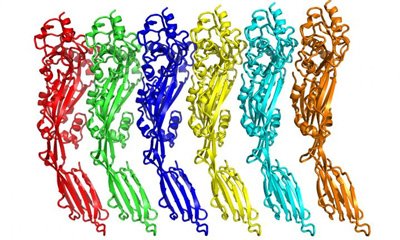Scientists use X-ray crystallography to see pneumolysin
Posted: 24 November 2015 | Victoria White
Pneumolysin is associated with deadly infections such as bacterial pneumonia, meningitis and septicaemia…


Figure shows the way that copies of the toxin pack together to form pores in cells. CREDIT: University of Leicester
Scientists from the University of Leicester have, for the first time, created a detailed image of the toxin pneumolysin.
Pneumolysin is associated with deadly infections such as bacterial pneumonia, meningitis and septicaemia.
The three-year study points to the possibility of creating therapeutics that block assembly of pneumolysin pores to treat people with pneumococcal disease.
Using X-ray crystallography at Diamond Light Source the Leicester team was able to see the individual atoms of the toxin.
Professor Russell Wallis, Departments of Infection, Immunity and Inflammation and Molecular and Cell Biology, explained: “Ours is the first detailed structure of pneumolysin. This level of detail is important and useful because it enables us to begin to understand how the toxin works. For example, we can see which parts of the toxin come together during pore assembly. When we disrupt these contacts, the toxin becomes inactivated so can no longer kill cells.
“The mode of action of pneumolysin action revealed by our work appears to be conserved in related toxins from other disease-causing bacteria e.g. toxins produced by pathogenic species of Listeria.”
Spin-out company set up to find drugs that target pneumolysin
Professor Peter Andrew, Head of Department of Infection, Immunity and Inflammation, said: “The determination of the structure of pneumolysin is a thrilling achievement that, worldwide, scientists have been pursuing for more than twenty years. It also offers the real prospect of enhancing our ability to find new drugs for treatment of pneumococcal diseases. Because of fears of antibiotic resistance, researchers have been trying for decades to find new antimicrobial drugs but with little success. A new approach is to identify new targets for therapy and our work over a long period shows that pneumolysin is an excellent target for new treatments. The University of Leicester set up a spin-out company to find drugs that target the toxin. Now the determination of the toxin’s structure is an important advance towards achieving this objective.”
The spin-out company mentioned by Professor Andrew is Axendos Therapeutics. The University set up Axendos Therapeutics with the aim of developing therapeutics that block pneumolysin.
Professor Wallis said: “The work is especially exciting because of the importance of pneumolysin towards pneumococcal disease and the devastating consequences of pneumococcal infections. Our work has provided new insight into how the toxin kills cells.”
Related topics
X-ray crystallography
Related organisations
Leicester University



